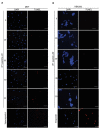Antimicrobial Peptide against Mycobacterium Tuberculosis That Activates Autophagy Is an Effective Treatment for Tuberculosis
- PMID: 33182483
- PMCID: PMC7697726
- DOI: 10.3390/pharmaceutics12111071
Antimicrobial Peptide against Mycobacterium Tuberculosis That Activates Autophagy Is an Effective Treatment for Tuberculosis
Abstract
Mycobacterium tuberculosis (MTB) is the principal cause of human tuberculosis (TB), which is a serious health problem worldwide. The development of innovative therapeutic modalities to treat TB is mainly due to the emergence of multi drug resistant (MDR) TB. Autophagy is a cell-host defense process. Previous studies have reported that autophagy-activating agents eliminate intracellular MDR MTB. Thus, combining a direct antibiotic activity against circulating bacteria with autophagy activation to eliminate bacteria residing inside cells could treat MDR TB. We show that the synthetic peptide, IP-1 (KFLNRFWHWLQLKPGQPMY), induced autophagy in HEK293T cells and macrophages at a low dose (10 μM), while increasing the dose (50 μM) induced cell death; IP-1 induced the secretion of TNFα in macrophages and killed Mtb at a dose where macrophages are not killed by IP-1. Moreover, IP-1 showed significant therapeutic activity in a mice model of progressive pulmonary TB. In terms of the mechanism of action, IP-1 sequesters ATP in vitro and inside living cells. Thus, IP-1 is the first antimicrobial peptide that eliminates MDR MTB infection by combining four activities: reducing ATP levels, bactericidal activity, autophagy activation, and TNFα secretion.
Keywords: antimicrobial peptide; autophagy; iztli peptide; multidrug resistant; tuberculosis.
Conflict of interest statement
The authors declare no conflict of interest. The funders had no role in the design of the study; in the collection, analyses, or interpretation of data; in the writing of the manuscript, or in the decision to publish the results.
Figures







Similar articles
-
Macrophage targeted polymeric curcumin nanoparticles limit intracellular survival of Mycobacterium tuberculosis through induction of autophagy and augment anti-TB activity of isoniazid in RAW 264.7 macrophages.Front Immunol. 2023 Jul 31;14:1233630. doi: 10.3389/fimmu.2023.1233630. eCollection 2023. Front Immunol. 2023. PMID: 37583694 Free PMC article.
-
Pasakbumin A controls the growth of Mycobacterium tuberculosis by enhancing the autophagy and production of antibacterial mediators in mouse macrophages.PLoS One. 2019 Mar 13;14(3):e0199799. doi: 10.1371/journal.pone.0199799. eCollection 2019. PLoS One. 2019. PMID: 30865638 Free PMC article.
-
Autophagy: A new strategy for host-directed therapy of tuberculosis.Virulence. 2019 Dec;10(1):448-459. doi: 10.1080/21505594.2018.1536598. Epub 2018 Nov 2. Virulence. 2019. PMID: 30322337 Free PMC article. Review.
-
MIR144* inhibits antimicrobial responses against Mycobacterium tuberculosis in human monocytes and macrophages by targeting the autophagy protein DRAM2.Autophagy. 2017 Feb;13(2):423-441. doi: 10.1080/15548627.2016.1241922. Epub 2016 Oct 20. Autophagy. 2017. PMID: 27764573 Free PMC article.
-
Autophagy-activating strategies to promote innate defense against mycobacteria.Exp Mol Med. 2019 Dec 11;51(12):1-10. doi: 10.1038/s12276-019-0290-7. Exp Mol Med. 2019. PMID: 31827065 Free PMC article. Review.
Cited by
-
Embedded-AMP: A Multi-Thread Computational Method for the Systematic Identification of Antimicrobial Peptides Embedded in Proteome Sequences.Antibiotics (Basel). 2023 Jan 10;12(1):139. doi: 10.3390/antibiotics12010139. Antibiotics (Basel). 2023. PMID: 36671338 Free PMC article.
-
ApoE Mimetic Peptide COG1410 Exhibits Strong Additive Interaction with Antibiotics Against Mycobacterium smegmatis.Infect Drug Resist. 2023 Mar 28;16:1801-1812. doi: 10.2147/IDR.S403232. eCollection 2023. Infect Drug Resist. 2023. PMID: 37013167 Free PMC article.
-
Antimicrobial Peptides as Potential Anti-Tubercular Leads: A Concise Review.Pharmaceuticals (Basel). 2021 Apr 2;14(4):323. doi: 10.3390/ph14040323. Pharmaceuticals (Basel). 2021. PMID: 33918182 Free PMC article. Review.
-
Rifampicin drug resistance and host immunity in tuberculosis: more than meets the eye.Trends Immunol. 2023 Sep;44(9):712-723. doi: 10.1016/j.it.2023.07.003. Epub 2023 Aug 3. Trends Immunol. 2023. PMID: 37543504 Free PMC article. Review.
-
Antimicrobial peptides as drugs with double response against Mycobacterium tuberculosis coinfections in lung cancer.Front Microbiol. 2023 Jun 2;14:1183247. doi: 10.3389/fmicb.2023.1183247. eCollection 2023. Front Microbiol. 2023. PMID: 37342560 Free PMC article. Review.
References
-
- Barbier M., Wirth T. Tuberculosis and the Tubercle Bacillus. 2nd ed. American Society of Microbiology; Washington, DC, USA: 2016. The Evolutionary History, Demography, and Spread of the Mycobacterium tuberculosis Complex; pp. 453–473. - PubMed
Grants and funding
- IG100513/Dirección General de Asuntos del Personal Académico, Universidad Nacional Autónoma de México
- IG100416/Dirección General de Asuntos del Personal Académico, Universidad Nacional Autónoma de México
- IN208014/Dirección General de Asuntos del Personal Académico, Universidad Nacional Autónoma de México
- IN208817/Dirección General de Asuntos del Personal Académico, Universidad Nacional Autónoma de México
- IN206518/Dirección General de Asuntos del Personal Académico, Universidad Nacional Autónoma de México
LinkOut - more resources
Full Text Sources
Molecular Biology Databases
Research Materials

